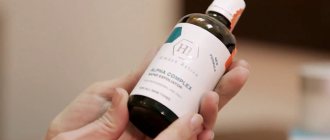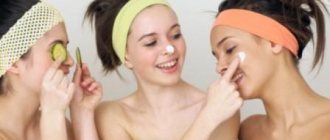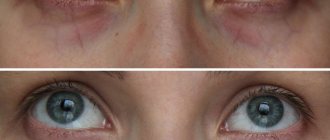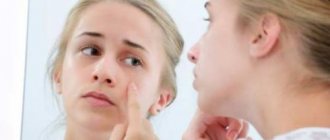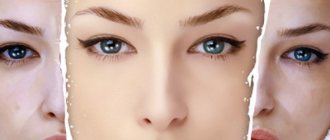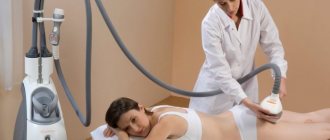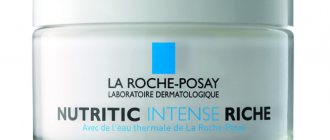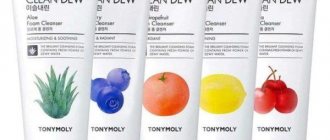From the age of 12-13, hormonal changes in the body begin, under the influence of which skin problems begin in adolescents. The sebaceous gland regulation system responds to a hormonal surge and is completely subordinate to it. From the age of 14, it is advisable for every teenager to begin special care for the skin of the face and certain areas of the body. To do this, you need to know what skin care for a teenager is optimal, taking into account his individual characteristics.
…
How to take care of a teenager's face to avoid acne. Localization of rashes
Mostly acne in a teenager appears on the face, chest and back, although the last 2 areas are affected only in case of serious internal problems. If we talk about the classic restructuring of the body of a healthy teenager, who is faced exclusively with a jump in hormone levels and, as a result, disruption of the functioning of the endocrine glands, he will see rashes exclusively on the face. However, even here only the nose, cheeks, chin or the entire surface can be affected.
Teenage acne in boys
Young men often experience transient acne, which is characterized by the formation of inflamed nodules that quickly give way to scars. This severe form of the disease mainly affects the face in the forehead and jaw line. With a serious lack of vitamin A, a rash will appear on the chest, and abuse of junk food against the background of chronic diseases of the gastrointestinal tract will make itself felt by pimples on the cheeks and in the triangular area around the mouth.
Acne in a teenage girl
Girls in most cases experience rashes caused by severe hormonal imbalance (in addition to the general increase in androgen levels, we cannot forget about menstrual cycles, which are unstable in adolescents), so acne appears on the chin and nose, in the forehead area. If the rashes affect the entire face or are grouped along the wings of the nose and go further to the cheekbones, there is a high probability of problems with the functioning of the sebaceous glands due to cosmetics.
Causes of problem skin in teenagers
Dermatologists name several main reasons that lead to unaesthetic pimples on young faces.
Hormones and stress
It is not for nothing that these two reasons are combined into one: acne on young skin is their common merit. In adolescence, during the period of hormonal changes, androgens become active, which refers to a group of steroid male hormones responsible for the growth of muscle mass and the formation of secondary sexual characteristics.
Despite belonging to men, they are activated both in boys and in smaller numbers in girls. A surge of androgens stimulates the sebaceous glands of the skin, causing them to begin to produce an excess amount of secretion that clogs the pores. It is these fat plugs that turn into foci of inflammation.
However, if this were the only reason, then boys would suffer from problem skin much more often than girls, but practice does not confirm this. Investigating this issue, doctors came to the conclusion that juvenile acne is caused not so much by the activity of androgens themselves, as by the heightened sensitivity of the skin to them. And stress increases it many times over.
That's why a first date, an exam, a graduation, or a simple lack of sleep associated with playing computer games is so often accompanied by a scattering of pimples appearing from nowhere on the skin.
Nutrition
The role of nutrition in the occurrence of acne on the skin of adolescents is twofold. On the one hand, dermatologists say that in adolescence, due to imperfect immunity, the likelihood of allergic reactions to even the most prosaic food increases. According to statistics, food allergies are diagnosed in adolescents twice as often as in adults, and can manifest not only as redness and itching of the skin, but also acne.
The second side of the issue relates to nutritional balance: if, due to the busyness of parents, most of the teenager’s diet consists of semi-finished products and buns, and in an educational institution, instead of visiting the canteen, he also prefers fast food, acne is inevitable.
With this type of diet, there is a significant deficiency of vitamins A and B, and their lack directly affects the condition of the skin.
An indirect sign of a lack of B vitamins in the body can be a craving for sweets and alcohol. Don't ignore these symptoms! It is necessary to organize a teenager’s diet so that it regularly contains natural meat, liver, fish, whole grain cereals, egg yolks, carrots and butter.
Insufficient or excessive hygiene
At any age, and especially in adolescence, it is important to observe measures in hygiene procedures. There is an opinion among children that pimply skin is a sign of unkemptness.
This is partly true: without regular cleansing, skin pores become clogged twice as quickly with epidermal scales mixed with sebaceous secretions. But excessively frequent washing, especially with the use of toilet soap, can also aggravate the problem, since the violation of the natural protective layer encourages the sebaceous glands to further increase the production of sebum. The optimal frequency of hygiene procedures is twice a day, upon waking and before bed.
Use of cosmetics and fatty creams
It is useless to say that cosmetics are harmful in adolescence. Girls are especially critical of their appearance, and, not having yet learned to love themselves as they are, they willingly decorate their faces.
The main scourge of the skin is the products that try to bring it into an ideal form - foundations and powders. This also includes using a rich day cream as a base for makeup.
Any cosmetic product that masks inflammation, thereby clogging the skin channels, can cause acne to appear or worsen existing ones.
Basic recommendations after the procedure
For young girls just starting to take care of their face, cosmetologists advise starting with cleansing the skin, moisturizing and nourishing it, adhering to the following recommendations:
be sure to cleanse your skin in the evening so that it can breathe while you sleep;
Daily facial care is a whole science. In order not to make a mistake in choosing cosmetics, it is better to use special sets of one brand, which include the entire care complex: cream, moisturizers and cleansers, gel, foam, lotion, tonic, scrub, face masks, protective equipment. The fact is that each line uses its own unique patented components.
To see what cosmetics there are for teenagers, see the following video.
In the near future, the cosmetics market for teenagers is expected to grow enormously, because there are very few specialized brands for teenage skin care. We offer several eco-lines with pure ingredients, because this is the only way to properly care for a child’s delicate skin.
- Oy! Skincare - a line of organic British brand Green People, created specifically for teenagers (Soil Association and EcoCert certificates) - Spots and Stripes - soft, specially developed cosmetics from the UK for teenage skin and hair care - Z{amp}amp;MA - organic brand from Paris for young skin (COSMEBIO certificate)
The task of parents is to prevent hormonal disruptors and other toxic substances from entering the child’s body at the threshold or during the process of colossal hormonal changes. With safe hygiene and care products, a healthy teenager will grow into a healthy adult.
At what age is it time to go to a cosmetologist?
Contrary to popular belief that it is necessary to visit a cosmetologist only in adulthood, I will say that children are also our frequent guests. Average age is 12-14 years.
Usually parents bring their children because they cannot cope with acne on their own. That's right: self-medication is fraught with unpleasant consequences! Young patients have a large number of rashes on their skin, and there are scars that form after improper treatment of acne. Of course, resurfacing cannot be done at this age, but if you have pronounced scars, I advise you to return to this procedure at 18 years old.
At a younger age, you can do a course of peelings to renew the skin of the face, back, and chest. They dry out and eliminate active inflammatory processes.
Indications and contraindications for facial cleansing
Despite the traditional and universal nature of the mechanical facial cleansing procedure, it has a number of contraindications:
- extensive inflamed rashes on the skin of the face;
- eczema;
- acute dermatitis;
- viral diseases of the body, especially herpes;
- scalp diseases;
- acute allergic reactions;
- rosacea and vascular network on the skin of the face;
- particularly sensitive skin;
- low pain threshold.
- Exacerbation of chronic diseases.
- Damage to the skin (wounds, scratches, infectious rashes).
- Cuperosis.
- Inflammations on the skin (ulcers, boils).
- Menstruation.
- Herpes, psoriasis, eczema.
Mechanical cleaning is not recommended for bronchial asthma and hypertension. During periods of extreme heat and severe frosts, cleaning is not carried out. As for pregnant women and nursing mothers, questions regarding the advisability of specific procedures are resolved on an individual basis. For those with dry and sensitive skin, it is not recommended to cleanse more than 3 times a month.
With this procedure, you can solve a number of unpleasant skin problems and noticeably transform. Facial cleansing in combination with proper care will help you if:
- There is acne, acne and post-acne on the face;
- Clogged pores;
- Black dots;
- The skin has lost its tone and healthy color.
Any type of cleaning is prohibited if there is at least one of the following contraindications:
- Herpes;
- Any skin diseases, especially in purulent form;
- Diabetes;
- Epilepsy.
Before you sign up for the procedure, you should go for a consultation with a cosmetologist, who will diagnose the skin and, if necessary, prescribe tests. This will help you choose a cleaning method that is right for you and will not entail dire consequences.
Facial cleansing is not recommended for the following diseases and pathological phenomena:
- herpes;
- eczema;
- pustular diseases of the scalp;
- bronchial asthma;
- diabetes;
- severe stage of hypertension;
- severe mental disorders;
- epilepsy.
Teen skin care
Appearance is important for comfortable communication with peers. A problematic approach to caring for the skin of a teenage girl is the use of a series of expensive cosmetic products. The choice is made based on the offers of aggressive advertising, the purpose of which is to sell the product.
All skin care at the age of 14 is usually limited to wiping the face with toner and applying cream or ointment from advertising, and takes 13 - 15 minutes a day. The result obtained from such “care” does not correspond to the expected effect.
At home
Only 10% of teenagers can boast of perfect skin - a genetic gift from mom and dad. Others have unhappy skin due to oily shine and blackheads.
How to properly care for your teenager's skin! First of all, do not follow established myths and follow advertising.
- Myth one: you can’t wash your face with water, you can only wipe with lotions and tonics.
- Myth two: You can’t use decorative cosmetics.
- Myth three: You can’t use fatty nourishing creams.
- Myth three: for each area of skin type - oily, dry - you need to use separate cosmetics.
- Myth number four: in the fight against oily skin and blackheads, extreme measures are good. The main thing is to dry the epidermis with alcohol lotions, apply deep cleansing daily using antibacterial agents and a facial brush.
Teenagers usually have combination skin - there are areas that are oily, dry and sensitive. Responds with inflammation to any irritation. Care products should be selected with the label “for sensitive skin” or “for combination skin.”
Constant irritation of the face with cotton pads with aggressive chemicals - alcohols, acids causes an inflammatory response of the epidermis.
You need to wash your face! Preferably boiled water with products for sensitive skin. Alternating warm and cold water regulates the activity of the sebaceous glands.
Infusions with medicinal herbs are effective for skin with inflammatory rashes. The easiest method is to buy a filter at the pharmacy - bags of chamomile, sage. Brew them according to the directions on the package and use to wash your face. Brewing green tea also has an antibacterial effect.
Crema
A medicinal cream or ointment prescribed by a doctor makes the skin dry and flaky. Their use should be combined with moisturizing and nourishing creams.
Reference. Nourishing fatty creams do not clog pores, but rather restore the barrier function of the skin, thanks to its saturation with exogenous fatty acids.
The skin's reaction to the effects of the cream is so individual that it can cause inflammation even to an expensive cream with good reviews.
Attention. There is no need to overpay for the inscription on the jar stating that the cream contains no substances that cause blockage of comedones. This statement is based on a single study from the 1980s. Since then, the cosmetology industry has come a long way.
Review of creams for the care of problem skin from leading cosmetic companies:
- Anti-acne cream “Ultra”, CLEARASIL , UK. The cream is intended for targeted application to problem areas. Ingredients: salicylic acid 2%, hydrogen peroxide 1.5%. The manufacturer promises visible results on the third day.
- Moisturizing cream for oily problem skin “Lipacid”, GIGI Cosmetic Laboratories , Israel. The active ingredients of the cream are plant extracts, zinc oxide, magnesium carbonate, allantoin, lecithin. The effect of using the product is promised in 4 procedures.
- "Skin Normalizing Balm", JANSSEN, Germany. Cream for the care of oily skin with acne. Suppresses the maturation of sebocytes. Calendula, horse chestnut and other plant extracts have an antibacterial effect.
- "Clear Phase Cream + SSR", JANSSEN , Germany. A unique cream for teenagers, correcting the hormonal levels of the skin of a teenager, suppressing the secretion of the sebaceous glands.
All of the above creams effectively help in the fight against acne, moisturize and nourish the skin. One drawback is the high cost of the cream. How did mothers and grandmothers get out of their situation before? We used what we had on hand.
To make the cream with your own hands, you still need to spend a little money by purchasing:
- Glycerin (its cost is about 16 rubles);
- Boric acid (about 40 rubles);
- Wax (about 60 rubles).
Old recipes use lanolin for cream, but recent studies have shown that it clogs pores. Therefore, there is no need to add problems.
Now you need to look into the refrigerator. To prepare the cream you need lemon or cucumber, vegetable oil. To prepare the cream you need:
- Finely chop the wax (1 tablespoon),
- Pour vegetable oil into the wax (3.5 tablespoons),
- Add boric acid (0.5 teaspoon),
- Place the mixture in a water bath;
- Cool the melted mass;
- Add glycerin (1 tablespoon) and lemon or cucumber juice (2 tablespoons) while rubbing thoroughly.
The prepared cream does not have a long shelf life; it does not contain strong preservatives. But it is very effective in moisturizing the skin and fighting acne.
Cosmetology procedures useful for the face of teenagers
If you believe the advertising of cosmetic products, then for oily skin you need to deep clean your pores every day. Advertising heavily promotes scrubs in the morning and evening. The new product is a cleanser with a brush that should clean all skin pores from impurities. To begin with, the pores are so small that plastic bristles simply will not penetrate there.
Attention! Dirt has nothing to do with acne! Acne-prone skin needs cleansers that are as gentle as possible!
If after cleansing your skin tingles and burns, then this cleansing is not working. This is a sign that the product is not suitable for a person! To obtain a short-term effect of purity and freshness, manufacturers add detergents (surfactants) to preparations that destroy the lipid barrier in order to deliver the necessary substances to the deep layers of the epidermis.
After intensive and constant use of such products, the skin condition worsens. By destroying the barrier function, aggressive chemicals open the door to bacteria in the sebaceous glands of the skin. And excessive stimulation of skin receptors leads to the release of neuropeptides that cause inflammation.
Anyone with problem skin should remove from their arsenal products containing:
- Alcohol,
- Acetone,
- Detergents (surfactants),
- Menthol oil,
- Eucalyptus oil.
Many formulations include active additives - benzoyl peroxide, azalaic and glycolic acids. They exfoliate the horny scales of the skin, improve the outflow of sebaceous secretions, inhibit keratosis, and kill microbes. All these remedies cause a skin response - the release of neuropeptides from nerve fibers and pushes the problem to a new level.
Therefore, having relieved the exacerbation with drugs with active additives for everyday use, you need to switch to plant extracts alternative to antimicrobial additives:
- Tea tree oil,
- Chamomile,
- Calendula,
- Birch,
- Willow,
- Green tea.
Cosmetic procedures that complement acne therapy in professional cosmetology:
- Comedon extraction with previous therapy with retinoids or azelaic acid. An alternative is ultrasonic peeling;
- Superficial cryotherapy;
- Laser therapy;
- Darsonvalization;
- Oxygen therapy;
- Photochromotherapy and photodynamics.
Methods available outside the salon:
- Cleaning the skin in a steam bath with medicinal herbs (oak bark, sage, chamomile, St. John's wort) with a water temperature of no more than 60°C (up to 10 minutes). Be sure to follow the procedure time. If there are dry areas on the skin, then the steam bath time should not exceed 3 minutes. The method is contraindicated for pustular rashes on the skin!
- Salt skin cleansing - shaving cream, “Extra” salt, soda. After the steam procedure, the mixture is applied to the face, paying attention to the areas where comedones accumulate.
- Warm vegetable oil softens and cleanses comedones well . It can be left on cleansed skin for 15 minutes. Afterwards you can do salt cleaning.
- Anti-inflammatory cleansing masks:
- Beat the egg whites with lemon juice. Apply for 5 minutes. Wash off with a cool infusion of medicinal herbs.
— Yeast, hydrogen peroxide 3%, dilute with herbal infusion to a consistency that will stick to the face. Apply the mixture for 20 minutes. Remove with a towel soaked in hot infusion. Rinse your face with cold water.
Such procedures should be carried out no more than once a week.
Nutrition
Nutrition should be balanced. No - fasting. No - overeating.
Sweet confectionery products, chips, and carbonated water contain elements that suppress and destroy vitamins necessary for adequate skin functioning.
Obesity caused by overeating triggers the production of hormones that affect the hypersecretion of the sebaceous gland.
Ultrasonic teeth cleaning
What is ultrasonic teeth cleaning? The essence of this method is to remove tartar and plaque from the enamel surface. For this purpose, a special device is used that applies ultrasonic vibration to the surface of the tooth. Thanks to this, even hard tartar can be easily removed from the surface. It is worth noting that during such manipulation the enamel is not damaged.
Ultrasonic teeth cleaning is a completely painless and harmless procedure.
The professional procedure includes:
- Removing plaque from the surface of the tooth, including that caused by food coloring or smoking.
- Root canal treatment.
- High-quality removal of supragingival and subgingival calculus using ultrasonic vibrations.
- Deep rinsing of periodontal pockets.
- Polishing the tooth surface using a special paste.
In addition, such an event gives a small whitening effect (about 2 tones) without the use of any chemicals.
Where to start caring for a cosmetologist?
The first place in popularity is occupied by cleansing. There are several cleaning options available in our clinic: classic ultrasonic, mechanical and combined. The process uses professional cosmetics that “loose” the skin, cleans it of impurities, helps open the pores and make them more accessible for cleansing.
The scheme is as follows: we cleanse the skin with cosmetics, then do ultrasonic cleaning; if comedones remain, we remove them mechanically. Then we apply a finishing mask that tightens the pores and a light moisturizer in the form of cream, gel or fluid.
Homemade cleansing masks
Made from baking soda and shaving foam. These ingredients are taken in equal proportions, mixed and applied to steamed skin. Leave for 15 minutes to act, and then you need to do a light massage with your hands and rinse off the remaining mixture. Those who are especially brave can use a moderately hard toothbrush for massage.
Honey-oatmeal. You will need: soda, honey, oatmeal, lemon juice, taken in equal quantities (1 tablespoon each). Apply to face, leave for 10 minutes, massage and rinse with warm water. 3. Yeast. Prepare a mixture from milk (3 tbsp) and compressed yeast (1 tsp). Allow the yeast to activate a little and apply to your face. Rinse off with warm water 10 minutes after the mixture has completely dried.
https://youtube.com/watch?v=t_dVGS0CEsU
Homemade scrub: coffee grounds, sea salt.
In a mixture of epithelial cells, sebum, polluting particles and dust from the surrounding air, pathogenic bacteria multiply very well. Local immunity is impaired, and rashes appear in almost 100% of cases.
Blackheads are nothing more than an accumulation of fat in enlarged pores and sebaceous ducts. They block the exit of sebaceous secretions, which protect the epidermis. The skin becomes dry, inflamed, and roughened. This is just one of the reasons why you need to have your face cleaned by a cosmetologist.
Here's what happens during the procedure:
removal of the upper keratinized layer of epidermal tissue; removal of comedones, blackheads, pimples, pimples; cleansing of toxins and impurities; restoration of pH level; normalization of the sebaceous glands (which is especially important for oily skin); stimulation of metabolic processes, blood circulation, production of own collagen and elastin; elimination of pigment spots; improvement of skin turgor, leveling of microrelief.
Choosing cosmetics for teenagers
Skin in teenagers is divided into main types, just like in adults. But more often it is combination or oily; normal and especially dry types are rare at this age.
In salon and home conditions, caring for teenage facial skin will not be complete and effective without the use of cosmetics intended for this age. Such cosmetics differ significantly in composition from skin care products for adults.
Important: The main purpose of using special cosmetics is to normalize the secretion of the sebaceous glands, dry the skin, eliminate its greasiness, cure acne and pimples, relieve inflammation and irritation. Many companies specializing in the production of skin care products produce lines of products for teenagers
They are usually presented as gels or foams for washing, drying tonics, and cleansing scrubs. If girls and boys do not have acne on their faces, during the period of hormonal changes in the body, you can get by with these basic cosmetics
Many companies specializing in the production of skin care products produce lines of products for teenagers. They are usually presented as gels or foams for washing, drying tonics, and cleansing scrubs. If girls and boys do not have acne on their faces, during the period of hormonal changes in the body, you can get by with these basic cosmetics.
If you have cosmetic problems in the form of rashes on the face and inflammation of the skin, you need to take care of your skin during adolescence using special products. Commonly used:
- lotion for deep cleansing of pores;
- shower gel;
- moisturizing milk;
- soothing cream;
- drying gel;
- matting agents;
- anti-acne products.
If you exclude the use of cosmetics intended for teenage skin, acne marks - scars and cicatrices - may remain on your face in the future.
Tips from cosmetologists
- Cosmetologists advise teenagers not to use alkaline soap to wash their face, as it creates an alkaline environment favorable for bacteria.
- If acne appears on the face, then it will appear on the body, which means it’s time to also use body care products to control the functioning of the sebaceous glands.
- Cosmetics containing alcohol and triclosan are strictly contraindicated.
- It’s good when teenager’s skin care contains ingredients such as: calendula, green tea, chamomile, prebiotics, vitamin B, lactic acid, aloe.
Problems on the facial skin of a teenager can cause not only serious problems associated with self-esteem, but also traces of abrasions and scars after getting rid of acne and comedones on your own. Therefore, a reasonable decision for parents would be to visit a cosmetologist with their teenage child. In this case, the specialist will be able to select the necessary care for the teenager, taking into account the degree of acne and individual characteristics.
Share your opinion in the comments, bookmark the article and share it with friends on social networks.
How often can you cleanse your face?
Now we understand how important it is to have a facial at a salon. But no one will carry out such a procedure every day.
Therefore, the question naturally arises: how often can you cleanse your face?
Let's turn on the logic:
- There are several skin types: dry/sensitive, oily/problem, combination, normal;
- There are several types of procedures: mechanical (manual), hardware (ultrasound, vacuum, laser and some others).
Therefore, how many times a month (quarter, half-year, year) to cleanse the face depends on the skin type and the manipulation itself.
Let's look at the specifics.
UZ
Ultrasonic facial cleansing is considered a universal procedure that is indicated for any skin type. Under the influence of ultrashort sound waves, the pores open and polluting particles are removed.
In order to understand how often you can cleanse your face using this method, you need to understand the essence a little. The manipulation consists of the following stages:
makeup removal, cleansing and application of products that loosen problematic accumulations (pimples, comedones, blackheads). Under the influence of special compounds, the pores open and the topmost layer of keratinized cells is removed; applying a special conductive gel, which is a kind of “conductor and amplifier” that improves the penetration of waves into tissues; surface treatment with a special device
The master runs a spatula-shaped nozzle over the surface, paying special attention to problem areas; applying a soothing gel and mask. The final stage is a moisturizer based on your skin type.
Any beauty salon will tell you that this procedure will not be able to remove deep comedones or clean too tight, narrow pores. It is rather a gentle cleansing for normal and dry epidermis. But in combination with mechanical cleansing, it is used for oily, problem skin.
Mechanical
Mechanical, manual, manual - these are the names of the same procedure. Its purpose is to remove deep comedones, fight acne, inflamed pimples, millet. Every woman who has such “charms” on her face will answer the question - why is facial cleansing necessary?
Manual cleaning in the salon is recommended for young ladies who have an oily skin type with enlarged pores, a tendency to form comedones, pimples and other unpleasant formations on the face.
The manipulation takes place according to the following scenario:
- make-up remover (a traditional stage of any cleansing);
- peeling to remove the keratinized top layer;
- steaming or applying a thermal mask. This stage prepares the skin, opens the pores, softens the contents;
- mechanical removal of all contaminants. The process is carried out by hand or with a special device (Uno spoon). Sometimes it is necessary to repeat the procedure after 2-3 weeks, since at the time of cleaning some pimples may not be ripe;
- treating the skin with an antiseptic. Next – soothing gel;
- applying a mask according to your skin type, followed by a moisturizer and protective agent.
It is recommended to do mechanical cleansing of a face with an oily type of epidermis and enlarged pores once every month to a month and a half. If there are associated problems (acne, pimples), it can be done even more often - once every 4-5 weeks.
Vacuum
Vacuum facial cleansing is a special hardware method that is indicated when the first age-related changes appear. During the procedure, using a special device that creates negative pressure, impurities and dead cells are absorbed. Let us note right away that manipulation will not be effective for problematic and oily skin, since it will not be able to remove deep comedones.
Why do facial cleansing with a vacuum? The following action can be provided:
- massage, lymphatic drainage;
- stimulation of blood circulation;
- acceleration of metabolic processes;
- stimulation of the production of protein compounds responsible for skin condition;
- elimination of congestion in the epidermis and dermis.
Vacuum facial cleansing can be done 3-4 times a year, not more often. Indicated for any skin type.
Laser
Laser exposure is a fairly new procedure that is gaining popularity. The principle of operation and stages of manipulation are similar to ultrasonic cleaning. Only the device generates a light beam, not sound.
After laser facial cleansing you can:
- get rid of sebaceous shine, normalize the functioning of the sebaceous glands;
- eliminate comedones, pimples (shallow);
- even out the relief, remove scars, cicatrices, traces of acne;
- improve complexion;
- increase skin elasticity, tighten the oval of the face;
- improve the functionality of the epidermis.
For women with any skin type that shows signs of age-related changes, laser facial cleansing is indicated. How often you can do this will be determined by a specialist.
Is it possible to cure acne at home?
Perhaps you are now making a decision whether to intervene in this teenage skin process or observe from the sidelines, or maybe you still have yet to decide. Remember: the more pronounced the inflammation and the longer the skin suffers from it, the less chance there is of smooth relief in the future. Of course, beauty is not happiness, but judging by the thousands of patients who annually seek acne treatment and removal of traces of youth from the face, it is not happiness either.
You won’t be able to cope with the growing inflammation yourself, just as you won’t be able to predict what will remain on the child’s face after it. A competent doctor is a necessary link here.
Some parents have to carefully monitor the implementation of the recommendations, others do not, but when the face begins to clear up, there are no limits to happiness. It’s simply amazing how a child who was initially distrustful and silent at the first appointment suddenly smiles at you and happily tells you about the first results.
What skin problems are most common for teenagers?
The most common are increased oiliness, enlarged pores, blackheads and inflammatory elements (acne or acne).
On the other hand, there are children and adolescents with atopic dermatitis and dry skin. Special care and proper washing are important for them (I talked about the products for both categories of patients in more detail at the link).




